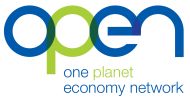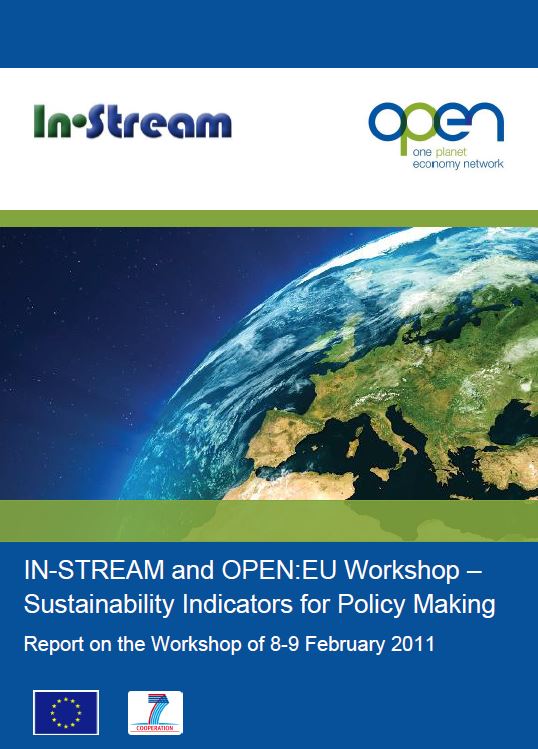As the world's largest economy, Europe must embark upon an immediate and major transformation to avert dangerous climate change and prevent ecosystem collapse. Currently, the impact of the European economy is nearly three times larger than what is required for a sustainable world. The goal of the One Planet Economy Network: Europe (OPEN: EU) Project therefore was to help transform the EU economy to a One Planet Economy by 2050.
Background
The One Planet Economy [1] concept is very simple. Whether we are dealing with a corner shop, a multi-national corporation, or the European Union as the largest economy in the world, we need to manage our assets and liabilities in a sustainable way and be aware of future risks and opportunities.
We need to think both short and long term, be responsible to suppliers and customers, and look after employees and stakeholders as well as shareholders. This is the way to organise an economy which lives well on One Planet instead of one that squanders the resources of three planets, as at present.
The One Planet Economy Network: Europe (OPEN: EU) Project had been designed to find ways to transform the EU-27 to a One Planet Economy [1] by 2050. The project started in September 2009, was funded by the European Commission (under FP7) and ended in August 2011.
Objectives
The OPEN: EU Project was working to produce a freely available, online, software tool called EUREAPA (EU Resource and Energy Analysis Programme Application). The EUREAPA tool was designed to enable national policy makers and NGOs to make better, more informed decisions about key areas such as food, housing, transport, services, waste, and energy and see how different socio-economic scenarios might affect human consumption and natural resource levels.
EUREAPA contains baseline data on the economy, greenhouse gas emissions, ecological footprints and water footprints for every EU member state and 16 other countries and regions of the world.
A key objective of the OPEN: EU Project has been to produce a set of academically robust “Footprint Family” indicators consisting of Carbon, Water and Ecological Footprint indicators and incorporate them into an environmentally extended multi-region input-output (MRIO) model, which combines tables from national economic accounts and trade statistics with data from environmental and footprint accounts. This MRIO model sits at the heart of the EUREAPA software tool.
The MRIO model uses The Global Trade, Assistance, and Production project 7 (GTAP7) as its data source. It has very extensive regional coverage and is a well-recognized database that has been used extensively for trade analysis, agricultural economics and tariff issues, and recently also for carbon footprint analysis. The extensive data system models the flow of goods and services between 43 countries and regions, covering the global economy for 130 individual sectors over a year. The model covers a range of sectors, from agricultural and manufacturing industries to transport, recreational, health and financial services. Supplemented with detailed carbon, ecological and water footprint data for hundreds of individual materials and products, EUREAPA can therefore account for the full supply chain impacts associated with the food people eat, the clothes they buy, the products they consume or the way they travel.
Using EUREAPA, it is not only possible to identify differences in footprints across countries from consumer and producer perspectives, but also to break down environmental impacts along global supply chains to identify footprint hot-spots.
This means that national or EU policy-makers and those who advise them are able to look at the impacts of EU consumption activities in the context of lifestyles or national differences. One of EUREAPA's most important functions is the scenario editor. This can be used to explore the environmental pressures associated with changes in population, consumption patterns, production technology or trade over time.
In the project, our aim was to use the information generated by the EUREAPA tool and scenario-modeling function to provide the intelligence necessary for understanding how we might transform the EU to a One Planet Economy [1] by 2050.
Alongside the more technical aspects of the project, another focus has been to engage with policy-makers, civil society organisations and the private sector as well as to raise awareness of the One Planet Economy [1] concept. We have been targeting potential EUREAPA users within EU member states, EC departments and private sector consultancies, inviting them to participate in the design of EUREAPA so that this software is fit-for-purpose, meeting their needs. We held a series of public workshops during 2010 and 2011. From February 2011 onwards, interested parties were invited to participate in a round of user-testing of a EUREAPA prototype to ensure that the software is easy to use.
At our Brussels workshop in September 2010, around 40 people worked collaboratively with the project to define different scenarios that could lead to a One Planet Economy [1] in Europe by 2050. A number of participants continued to work with the project to define appropriate policy measures within these scenarios that will hasten Europe's transition to a One Planet Economy [1] by 2050.
Through these engagement activities, the project has established the One Planet Economy Network, which brings together organisations from the public, private and civic sectors, to engage in a dialogue process, to share visions, knowledge, and interests and identify ways to transform the EU-27 to a One Planet Economy [1] by 2050.
A OPEN:EU project brochure is available for download.
[1] A One Planet Economy is an economy that respects all environmental limits and is socially and financially sustainable, enabling people and nature to thrive.







